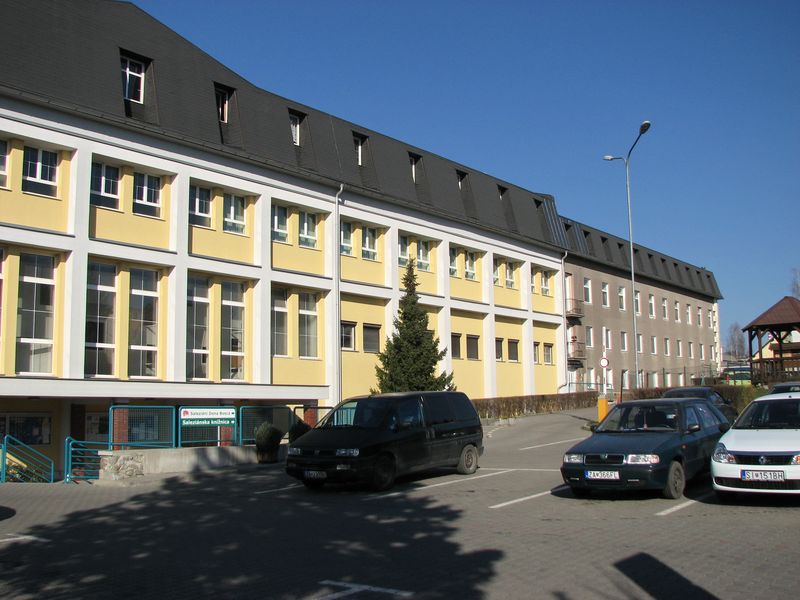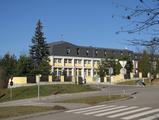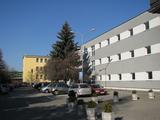Žilina Gallery
» Mesto Žilina » História a archeológia » Pamiatky – QR kódy » Pamiatky QR kódy II » 62 Saleziánsky ústav
7/12
62 Institute of Salesians (EN)

62 – Church and institute of Salesians in Žilina, Rajecká Road 17
Turistická informačná tabuľka č. 62 s QR (Quick Response) kódom na Saleziánskom ústave(Foto: 12. 3. 2014)
Church and institute of Salesians: The Society of St. Francis de Sales is a small religious community, which was founded by an Italian Catholic priest called St. Don Giovanni Bosco (1815-1888). He was born on 16 August 1815 in Beccchi, Italy, in a poor family. His father's name was Francis and his mother was called Margarita. His father died when he was two years old and his mother raised the children alone. Thanks to their talents and his extraordinary memory, he successfully completed both primary and grammar school in four years. While he was a student he founded an association called Allegri (Joyful) to discourage his friends from sinful amusement and lead them to God. He wanted to become a priest, but could not decide whether to enter the Order, or join the seminary. Finally he became a diocesan priest. In 1841 he began to bring together boys and street urchins whom no one cared about. Some of them were barely 14 years old, while others were almost 20. Don Bosco’s principle was be merry, play, but do not sin. The noisy parties the boys had disturbed the neighbours and the priests considered Don Bosco a fool. As time passed, there were hundreds of boys hanging around him. He managed to buy an outhouse and Mr Minardi’s house in Turin and he gradually built other buildings including a church and set up an elementary and vocational school with workshops. He founded a printing house that is still in operation today. On 18 December 1859 a new organisation came into being. It was founded by two priests - Don Bosco and Don Alasonati – and young clerics. However, it was not officially approved until ten years later on 1 March 1869. The main patron was the Virgin Mary and the cathedral in Turin is dedicated to her. In 1872 Don Bosco and Mary Dominica Mazzarello founded a religious order for women bearing the name Daughters of Mary Help of Christians. Its mission was to provide an upbringing for girls. During Don Bosco’s lifetime the Salesians spread to many countries of the world. He built a number of places of worship, for example, the Church of the Sacred Heart of Jesus in Rome. He died on 31 January 1888 at the age of 72. Over one hundred thousand people attended his funeral. He was declared a saint in 1934.
The Salesians of Don Bosco were originally known as the Society of St. Francis de Sales - hence the "Salesians". They focused on educating young people and have been in Slovakia since 1924. They were invited to Žilina by a priest, Tomáš Ružička, on 19 December 1936. In July 1937 the foundation stone of the Salesian Institute was consecrated. Construction of the building was finished in the following year. The first rector of the Institute was Don Ľudovít Žilka (1905-1957). In 1939-1941 Peter Rajtár (1922-1990) worked as a catechist and head of the school in Žilina. With effect from 3 August 1948 all property registered as church property became the property of the state. This ruling affected a number of buildings in Žilina - especially monasteries. The priests then found themselves being persecuted. Žilina priest ThDr. Andrej Paldan (1906-1984) was sentenced to 24 months in prison without cause on 21 May 1949. He was released after six months when he broke his leg. In the spring of 1949 the state security services began a concentrated campaign against the religious community in Slovakia. By the end of the 1948/1949 school year, a total of 17 Salesian and Jesuit institutions had been brought under state control. In late June, the authorities working alongside the state security services expelled all the wards members of the clergy from the Salesian institute in Žilina. The church was closed and its property was taken by other institutes in Slovakia. The Roman Catholic parish became the administrator of the Salesian diocese in Žilina. After November 1989, many things changed and the fall of communism meant the restoration of freedom for religious communities. The public authorities gradually returned many buildings which had previously been the property of the Church. The Salesians also obtained their institute in Žilina under a special restitution law.
The Salesian building and church were designed by Michal Maximilian SCHEER between 1937 and 1938. It was used by the National Security Corps – as the police were known from 1950 to 1990. Later the Ministry of Interior Fire Brigade High School was based here. A plaque indicates that bishop Vojtašák was imprisoned here. On 1 April 1990 two Salesian priests – Don Ing. Kamil M. Kutarňa and Don Ing. Štefan Urban – started working with young people in the Žilina parish. They took over the building in August 1990, establishing a chapel, a youth centre and a vocational school. The street on which the Salesian community is based is now called Salesian Street. Students of various crafts took part in archaeological excavations at the Church of St Štefan in May and June 1995. In September 1990 the Bishop's Office in Nitra renewed the parish incorporating Hliny VII district, the area around the Salesian Institute and Bánová district. Don Ing. Kamil M. Kutarňa became the parish priest and there were two other chaplains. In December 1993, the Salesians began holding mass on Hájik housing estate as well. Don Štefan Turanský has served this area, Žilina’s newest housing estate, for nine years.
The first rectors of the institute in Žilina: Don Ľudovít Žilka (1905 - 1957) studied theology in Turin, where he became an ordained priest on 8 July 1934. First he lived in Bratislava and in 1938 he became the first rector of the Salesian Institute in Žilina. He worked there until 1941. From 1952 onwards he lived in illegality until he was arrested on 28 September 1955. He was imprisoned in Šaštín and Podolinec, and he was subjected to forced labour in Osek near Duchcov. He was then transferred Bratislava, where he died under torture. Don Ján Šebela (1907 - 1992) applied to study with the Salesians in Italy in 1921. In Genzane, near Rome, he graduated from high school and in 1923 he entered the novitiate at the age of 16. After graduating in philosophy he taught in Rimini and Ancona, Gualdo Tadino, between 1925 and 1930. He began work as a priest in Bratislava, where he became the rector and mentor of the Slovak Salesian inspectorate in 1939. In 1941 he became rector of Salesian house in Žilina. From 1943 on he worked in Nitra and then in Topoľčany. Don Štefan Faber (1909 - 1985) joined the Salesians in Šaštín and passed his novitiate at the Gregorian University in Rome, where he was ordained as a priest on 26 July 1936. After his return home he continued his studies at the University of Bratislava, where he studied chemistry and natural sciences. In 1945 he became head of the new parish, and rector of the Salesian Institute in Žilina and after three years he took up a similar position in Michalovce.
Source: Mgr. Jozef Moravčík. Text prevzatý z webovej stránky TIK Žilina (kliknite): www.tikzilina.eu.
preberanie textov a obrázkov bez zvolenia autora je striktne zakázané
Site Map
Powered by PhpWebGallery
Site Map
Powered by PhpWebGallery


[0] Komentárov